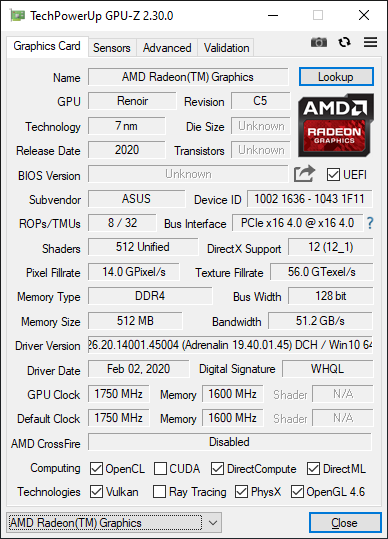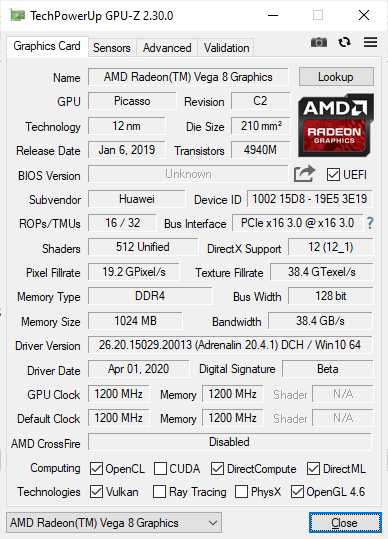AMD’s Mobile Revival: Redefining the Notebook Business with the Ryzen 9 4900HS (A Review)
by Dr. Ian Cutress on April 9, 2020 9:00 AM ESTTesting the Ryzen 9 4900HS Integrated Graphics
Under the hood of the Ryzen 9 4900HS, aside from the eight Zen 2 cores, is an enhanced Vega 8 graphics solution. For this generation of mobile processors, AMD is keeping the top number of compute units to 8, whereas in the previous generation it went up to Vega 11. Just by the name, one would assume that AMD has lowered the performance of the integrated graphics. This is not the case.
For the new Ryzen Mobile 4000 processors, the Vega graphics here are enhanced in three main ways over the previous generation. First is that it is built on the 7nm process node, and AMD put a lot of effort into physical design, allowing for a more optimized version that has a wider voltage/frequency window compared to the previous generation. Secondly, and somewhat connected, is the frequency: the new processors top out at 1750 MHz, rather than 1400 MHz, which would naturally give a simple 25 % boost with all other things being equal. Third on the list is memory, as the new platform supports up to DDR4-3200, rather than DDR4-2400, providing an immediate bandwidth boost which is what integrated graphics loves. There’s also the nature of the CPU cores themselves, having larger L3 caches, which often improves integrated graphics workloads that interact a lot with the CPU.
Normally, with the ASUS Zephryus G14, the switching between the integrated graphics and the discrete graphics should be automatic. There is a setting in the NVIDIA Control Panel to let the system auto-switch between integrated and discrete, and we would expect the system to be on the IGP when off the wall power, but on the discrete card when gaming (note, we had issues in our battery life test where the discrete card was on, but ASUS couldn’t reproduce the issue). In order to force the integrated graphics for our testing, because the NVIDIA Control Panel didn’t seem to catch all of our tests to force them onto the integrated graphics, we went into the device manager and actually disabled the NVIDIA graphics.
This left us with AMD’s best integrated graphics in its Ryzen Mobile 4000 series: 1750 MHz of enhanced Vega 8 running at DDR4-3200.

Renoir with Vega 8 – updated to 20.4 after this screenshot was taken
Our comparison point here is actually a fairly tricky one to set up. Unfortunately we do not have a Ryzen 7 3750H from the previous generation for comparison, but we do have an Honor Magicbook 14, which has a Ryzen 5 3500U.
This is a 15 W processor, running at 1200 MHz and DDR4-2400, which again makes the comparison a little tricky, but it is better than comparing it to the Intel HD630 graphics in the Razer Blade.
We also re-ran the benchmarks on the latest drivers with AMD's 65 Desktop APUs, the Ryzen 5 3400G (with Vega11) and the Ryzen 3 3200G (with Vega 8). These are running at DDR4-2933, the AMD maximum officially supported by these APUs (which means anything above this is overclocking).


This is a pretty substantial difference, no joke.



Hopefully we will get more variants of the Ryzen integrated graphics to test, along with an Ice Lake system.











267 Comments
View All Comments
Deicidium369 - Monday, April 13, 2020 - link
The C920 is nice unit - next to impossible to find at the moment - bought mine a while back - a C920S - which has the privacy shutter.Deicidium369 - Monday, April 13, 2020 - link
It is most definitely progress, without a doubt.lightsout565 - Tuesday, April 14, 2020 - link
Battery life is incredible. I really wish Asus had an option to lock the display to 60Hz if the dGPU was off like you mention Razer does. Or even better lock the display to 60Hz if the dGPU is off *AND* on battery power. The latter of the two seems like the best solution. It's too bad we aren't seeing more OEMs put these in higher end laptops. This along with new Nvidia Max-Q tech seems to be the perfect recipe for thin and light 13-14" laptop designs that the 45w H chips could never quite deliver on.x86koala - Tuesday, April 14, 2020 - link
Excellent performance!Felfazeebo - Wednesday, April 15, 2020 - link
Should you expect a performance hit if you were to add another stick with 3200mhz instead? I was planning on adding a 16gb 3200mhz stick in the hopes of running 24gb all in 3200mhz. I'm curious to know if it will even run at the right speed, and whether it will be as fast, or very close to the stock 16gb at 3200.Qasar - Wednesday, April 15, 2020 - link
i think this was address in the articleGreenReaper - Monday, April 20, 2020 - link
By the look of it, it could, but it maybe won't by default. You would might well have to re-program the module (if you can find a way to do that, it may involve a hardware hack) or else wait in hope for ASUS to offer an update enabling XMP.I think there should have been more pushing on the manufacturer of this point, as many are likely to install aftermarket memory sooner or later.
carcakes - Wednesday, April 22, 2020 - link
If the infinite fabric version for Ryzen Mobile 4000 series is newer than the previous one how much will it impact performance?carcakes - Wednesday, April 22, 2020 - link
'The 2nd Gen Infinity Architecture will allow for 4-8 Way GPU connectivity in a singular node'mi1400 - Saturday, April 25, 2020 - link
I dont know why this and similar processors are not packaged in decent streamlined chassis like Lisa Su is holding to introduce this cpu. Dear ASUS, MSI stop making chassis(s) for drag-queens, most of us are descend corporate employees who dont want to flash/swing their "assets" out and about. Current day programming/cloud/vms/containers demands are making people like me desperate for such processors BUT in decent/sleek/non-intrusive chassis designs and you are holding us back. I understand heat dissipation and other factors may push u for this but it is still not the excuse. Lenovo etc are making mobile workstation which are slimmer and less flashy than asus one above. Take few pages from phone designs like Samsung Note, Xperia Z Ultra.. world has changed .. dont remain stuck in mid-late 2000s. Just phone Lisa Su where she got that chassis.